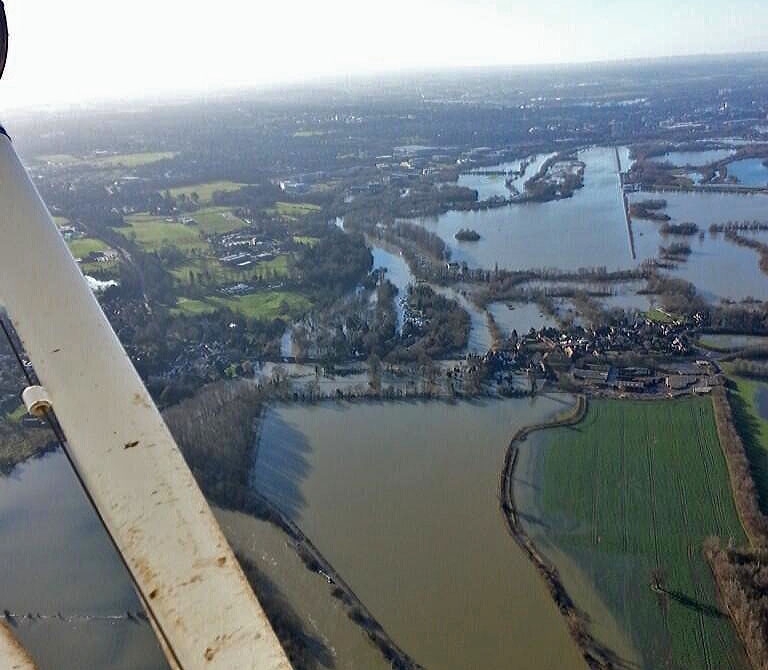It seems appropriate that in the year of the 70th anniversary of the great floods of March 1947, Oxfordshire has chosen to launch a new online ʽFlood Toolkit’ to assist those exposed to flood risk. It aims to provide a suite of solutions to help communities like Sonning Eye to better prepare for a major flood.
In times past such sophistication was unimaginable, but in spite of this, the realities remain much as they always have been.
In the March 1947 issue of the parish magazine, Canon Groves wrote ʽWe are all deeply concerned as to the sorry plight in which the Sonning Eye folk have been plunged by the floods and to a lesser degree by the gale, and can only hope that by the time these words reach your eyes the waters will have gone down and the houses be once more dry and clean, and habitable—but how many houses in Sonning Eye are really habitable? This disaster has shewn up afresh the lack of decencies, not to say the amenities of life, from which our parishioners in the Eye suffer; it seems difficult to believe that either the local authority or the landlords have done their duty by these people; callous neglect stares one in the face on every side. Now that the war is over, such conditions must no longer be tolerated’.
1947 has become a benchmark against which all other floods are judged. A rapid thaw and high rainfall caused rivers like the Thames to rise by a foot an hour. Over 100,000 properties were flooded nationally – far worse than any 21st century flood event. Over 1,600 homes were flooded in Caversham, making it a once in 200 years flood event. Canada sent food parcels and in Gloucester the Australian Red Cross helped out.
Even worse were the floods in 1894 when the daughter of the manager of Sonning Mill wrote from the Barn House in Sonning Eye of their neighbours ʽin much trouble with rooms flooded and furniture floating, so Mother and Father decided to invite three people into our house. Mr Greenfield brought his wife and little girl Amy, separately upon his back, walking on planks down our drive. The planks were resting on bricks. People were very perturbed as the water kept rising. Father prayed and God answered...’
Today the best opinion of climate change experts is that global warming is worsening Thames flooding, so how does Oxfordshire County Council’s new initiative shape up?
For individual householders, a series of flood mitigation measures are proposed. These begin with simple external work to help keep water out, extending to complete internal tanking and permanent barrier systems costing many tens of thousand pounds.
For communities such as ours, a raft of ten strategies are intended to make them more flood resilient. These begin with community flood risk and mitigation reports which lead to the preparation of community emergency plans. These schemes require the work of dedicated volunteers, many of whom are already over-committed. Scottish and Southern Energy offer grants of up to £20,000 to support community resilience projects in their areas. The money can be used both for flood prevention measures as well as to provide for emergency response kit. New technology is also increasingly being used to collect better information about flood and rain levels in ways that can help predict severe flooding with greater accuracy.
Aside from these grand and possibly impractical schemes, what is the reality for Sonning Eye? Many resent any publicity which draws attention to flood risk in their area, fearing a detrimental impact on house values. In fact that risk is well-known, even if only crudely documented by the national flood mapping system. The majority of houses in Sonning Eye lie just above the ʽfunctional floodplain’ for a one in 30 year flood event. Those at risk are keenly aware that local flood patterns are complex and likely to be influenced both by ground and surface water levels and that no matter what, water will eventually rise of its own accord beneath their homes.
The lush water meadows around us have for centuries provided land over which the rising Thames can spread, averting the worst consequences of flooding. Any changes to that floodplain, such as building works or the new gravel extraction and landfill works about to begin, are likely to have an impact on flooding which even the best experts find it hard to precisely quantify. Those that love living here must decide for themselves if the risks are counter-balanced by the joys of living on the edge of Old Father Thames.
http://forms2.rms.com/rs/729-DJX-565/images/fl_1947_uk_river_floods.pdf
http://www.climateprediction.net/human-influence-on-climate-in-the-2014-southern-england-winter-floods-and-their-impacts/
